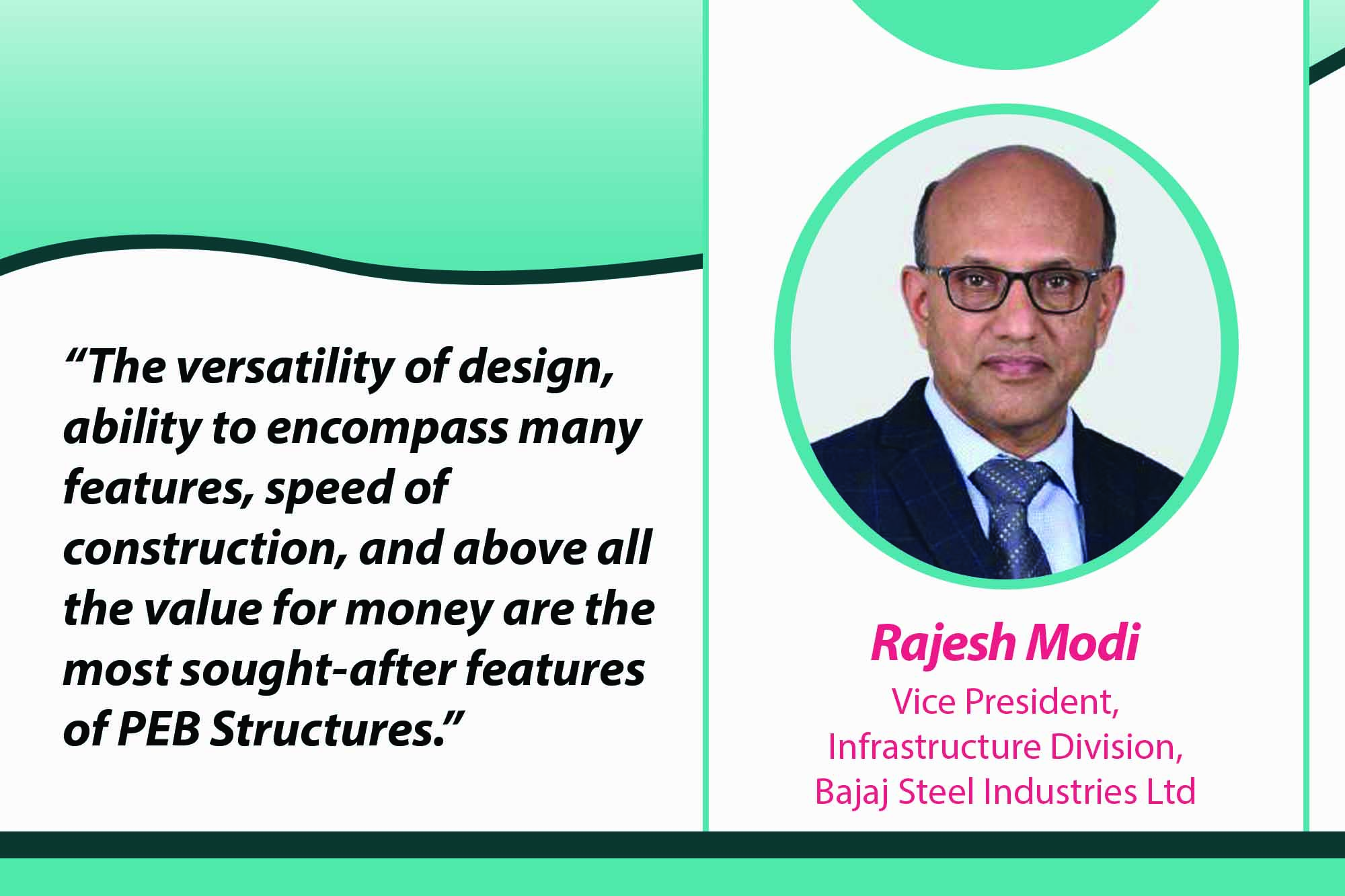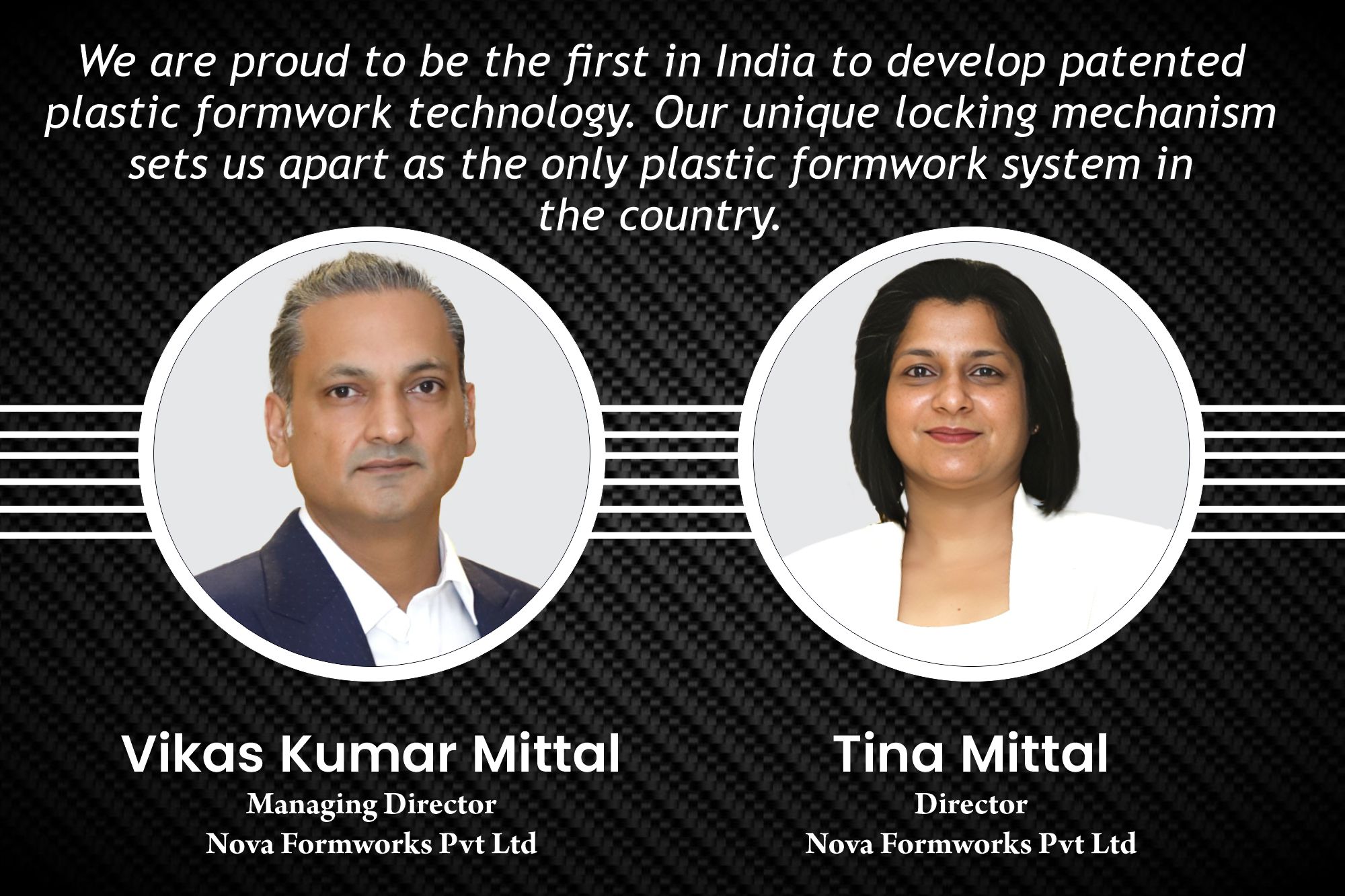PEB Structures deliver unparalleled cost-effectiveness and dynamism
By Edit Team | June 11, 2024 5:06 pm SHARE

Rajesh Modi, Vice President of the Infrastructure Division at Bajaj Steel Industries highlights PEB’s unparalleled advantages.
He emphasises that its flexibility, coupled with the increased demand for green buildings and the surging need for reduced construction time and costs, has propelled PEB Structures to the forefront of the industry.
Bajaj Steel Buildings are used in various sectors, such as factories, warehouses, and mining shelters. Could you elaborate on how your products cater to the specific needs of these industries?
The core business of Bajaj Steel Industries Ltd (BSIL) is Cotton Ginning and Pressing Machinery manufacturing. Bajaj Infrastructure Division is a part of Bajaj Steel Industries Ltd. 2010 the Infrastructure Division was formed to cater to the cotton ginning industry. But over time, we have evolved into a dynamic and strong presence catering to a wide variety of structures like Industrial Buildings, Warehouses, Sports facilities, Transport sheds, Metro stations, Cold Storage buildings, rise buildings, Schools, Special facilities catering to Food, Pharmaceuticals and structures catering to extreme weather conditions. We export our structures to more than ten countries across Africa, Europe, the Middle East, and Latin America. With over 1000 projects under our belt, we are a leading player in the PEB segment.
Each structure meets the requirements of design stipulations and exceeds customer expectations for utility and usage, along with the rapid development of industrial infrastructure. We have used the most advanced materials, paints, and technologies to ensure that our structures stand the test of time, environment, and work conditions. A testament to our product quality is the repeat orders from our customers, not for one other shed but multiple ones.

What are the key benefits of using your Pre-Engineered Buildings in the context of the construction and infrastructure sectors?
The biggest benefit of a Pre-Engineered Building is its versatility. The ability to mould the structure to suit every customer’s need is best achieved through a PEB Structure. There is increased demand for green buildings and surging demand for reduced construction time and costs. The versatility of design, ability to encompass many features, speed of construction, and, above all, value for money are the most sought-after features of PEB Structures.
The largest structures, such as the Vehicle Assembly Building of a spacecraft, aircraft hangars, and Industrial structures for every type of manufacturing and service, and the smallest structures, like affordable housing, can all be done in PEB. PEB Structures are the most cost-effective and dynamic solution for most structural constructions.
Can you discuss the role of advanced technologies, such as high-definition fibre laser cutting and CNC machines, in manufacturing your PEBs?
Technology helps improve products, and PEB Structures are no exception. There has been a huge change in the PEB scenario over the years. The use of the latest software, types of machinery, testing methods, and erection practices has ensured that the PEB structure of today is high precision, quality, and speed of manufacturing, very cost-competitive, strong, durable, and capable of incorporating a large number of features.
BSIL uses the latest software, like MBS, to design structures and TEKLA to detail the individual components of the structure. Most of the production is done via machines like CNC Laser Cutting machine, CNC Plasma cutting machines, CNC Shearing machines, CNC “H” Beam Welding machines, CNC Purlin and Girt manufacturing machines, CNC downtake pipe manufacturing along with SPMs like fabrication jigs, threading by Chasers on sag rods and anchor bolts, CNC Punching and CNC Sheet profiling machines. The use of modern technology machines helps us improve quality, shorten delivery timelines, and provide better aesthetics.
How do mezzanine floors, crane beams, and roof platforms enhance the usability of PEBs in industrial applications?
Greater space utilisation, efficient handling of material and equipment, and provisioning of utilities add to the many features of an industrial setup. A PEB structure is most efficient and effortlessly achieves these.
BSIL has always provided efficient design solutions using state-of-the-art software and best machining practices to our clients. Based on the client’s recommendations and needs, we have designed structures to carry 50MT EOT cranes and created full mezzanine structures and roof platforms to accommodate Active Fire Fighting services, Cable trays, Rooftop Solar Panels, and more.

How do PEBs contribute to faster project completion and reduced construction costs? Can you share any specific case studies or examples?
A PEB structure is designed, manufactured, and painted using modern software and equipment inside a factory. These are transported to the site and erected. The ability to use modern equipment, utilise the resources of an industrial setup, and produce a structure to the exacting standards and dimensions of the design enables an error-free, fast, and as-designed structure. Since the product has been manufactured as per design, it is effortlessly assembled at the site with erection equipment and a dedicated and skilled erection team. There is no need for additional fabrication work at the site, and the erection work is smooth and seamless.
How does Bajaj Steel incorporate sustainable practices into its operations?
Bajaj Steel Industries Ltd ensures we give back to the environment and society by utilising sustainable production practices. The use of Solar Panels to produce electricity for self-consumption has helped reduce the carbon footprint. BSIL has ensured that the plantation is covered in green at all workplaces. BSIL ensures using environment-friendly processes and treats effluents and wastages before discharge for disposal.
BSIL promotes students and aspiring professionals by awarding scholarships and incentives to enable better learning and ensure a talent pool. As a pioneer and a leader in the industrial community, BSIL has been a leader and a voice for the industrial community.
How do you foresee the future of Pre-Engineered Buildings evolving, and what innovations can we expect from Bajaj Steel in this domain?
PEB buildings and structures are estimated to be a USD 24 billion industry by 2027 and are expected to grow in double figures for the next 20 years. Lightweight structures, superior materials, and corrosion-resistant sheeting backed by advanced manufacturing processes are cornerstones for increased structure life, reduced maintenance, and lower weights. BSIL actively focuses on multiple value-added features to provide its customers with a PREMIUM PEB experience.
A new cladding material with NANO Technology has been introduced for the Indian market. It will have a superior anti-corrosion steel–aluminium composite coil formed with aluminium foil and PET—a NANO material layer. This material has excellent temperature resistance between -20°C and 100°C and good anti-aging performance. This new introduction is part of Bajaj Steel’s customer-centric approach.
For more information, visit: https://bajajngp.com/
Cookie Consent
We use cookies to personalize your experience. By continuing to visit this website you agree to our Terms & Conditions, Privacy Policy and Cookie Policy.






































































